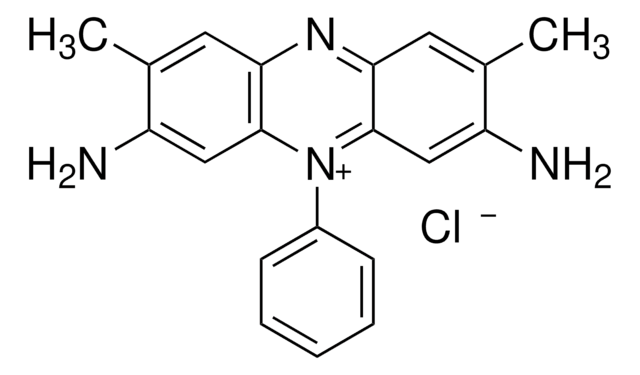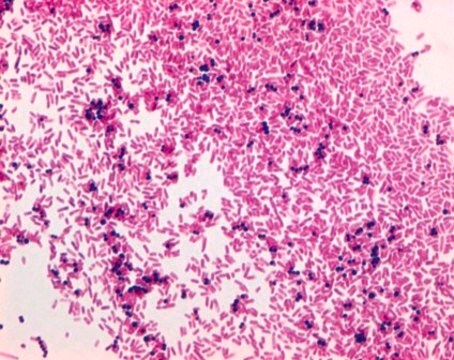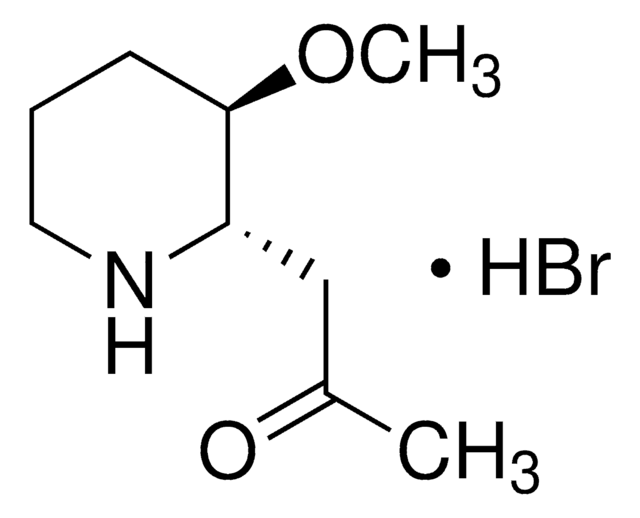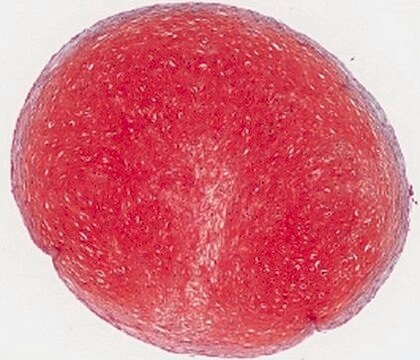94635
Gram′s safranin solution
for microscopy
Synonyme(s) :
Safranin T solution
About This Item
Produits recommandés
Qualité
for microscopy
Niveau de qualité
Forme
liquid
Durée de conservation
limited shelf life, expiry date on the label
Composition
ethanol, 10%
Technique(s)
microbe id | staining: suitable
Couleur
red to very dark red
Indice de réfraction
n20/D 1.339
Solubilité
water: soluble at 20 °C
Densité
0.986 g/mL at 20 °C
εmax
4.0 at 532 nm in 50% ethanol
Adéquation
suitable for microscopy
Spectre d'activité de l'antibiotique
Gram-negative bacteria
Gram-positive bacteria
Application(s)
diagnostic assay manufacturing
hematology
histology
Température de stockage
room temp
Chaîne SMILES
[Cl-].Cc1cc2nc3cc(C)c(N)cc3[n+](-c4ccccc4)c2cc1N
InChI
1S/C20H18N4.ClH/c1-12-8-17-19(10-15(12)21)24(14-6-4-3-5-7-14)20-11-16(22)13(2)9-18(20)23-17;/h3-11H,1-2H3,(H3,21,22);1H
Clé InChI
OARRHUQTFTUEOS-UHFFFAOYSA-N
Vous recherchez des produits similaires ? Visite Guide de comparaison des produits
Description générale
Application
- as a non-toxic replacement for crystal violet for the quantification of biofilm formation
- to develop a hyaluronic acid visualization method
- to study improved β-lactam susceptibility against biofilm-embedded staphylococcus aureus by 2-aminothiazole
Caractéristiques et avantages
- Ready-to-use solution.
- Modified and designed in such a way that staining can be carried out in staining cells, on the staining rack, and in automated staining systems.
Principe
Mention d'avertissement
Warning
Mentions de danger
Conseils de prudence
Classification des risques
Flam. Liq. 3
Code de la classe de stockage
3 - Flammable liquids
Classe de danger pour l'eau (WGK)
WGK 2
Point d'éclair (°F)
114.8 °F
Point d'éclair (°C)
46 °C
Équipement de protection individuelle
Eyeshields, Faceshields, Gloves, type ABEK (EN14387) respirator filter
Faites votre choix parmi les versions les plus récentes :
Déjà en possession de ce produit ?
Retrouvez la documentation relative aux produits que vous avez récemment achetés dans la Bibliothèque de documents.
Les clients ont également consulté
Articles
Clostridia are relatively large, gram-positive, rod-shaped bacteria that can undergo only anaerobic metabolism.
An article regarding the Role of Clostridium perfringens and their detection, identification, and differentiation from Sigma-Aldrich.com
On the Trail of Campylobacter
For microbiologists the most fundamental stain was developed in 1884 by the Danish bacteriologist Hans Christian Gram.
Notre équipe de scientifiques dispose d'une expérience dans tous les secteurs de la recherche, notamment en sciences de la vie, science des matériaux, synthèse chimique, chromatographie, analyse et dans de nombreux autres domaines..
Contacter notre Service technique








